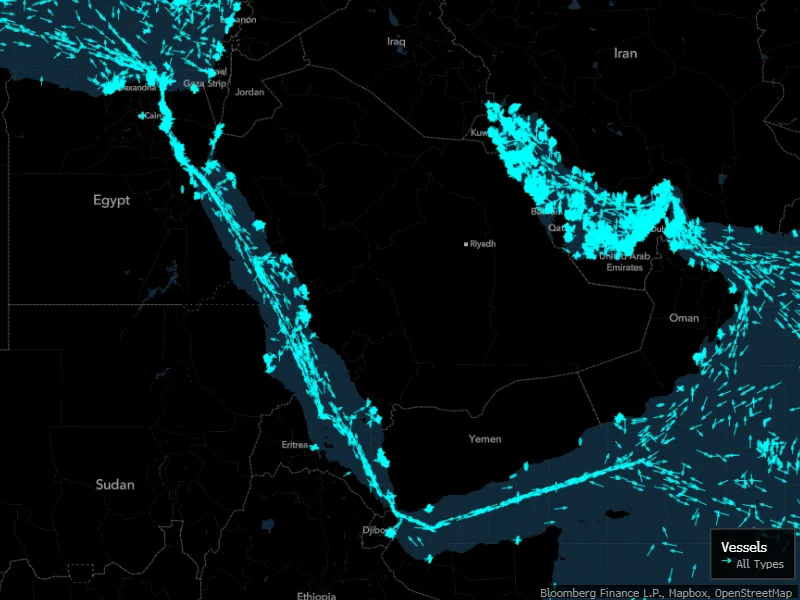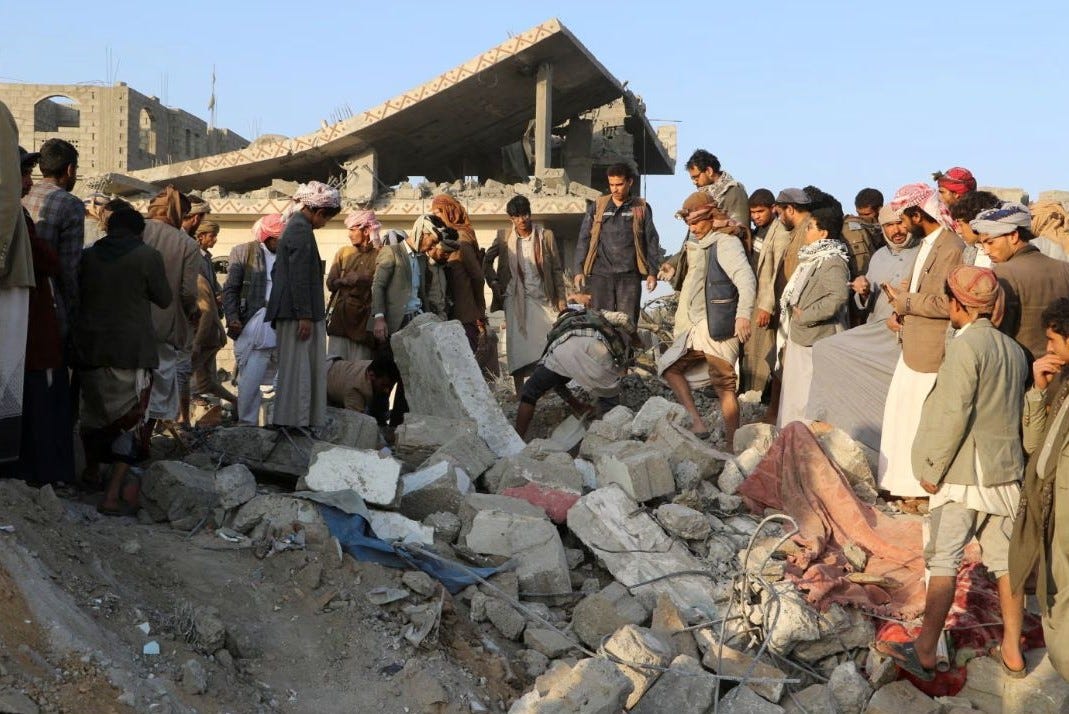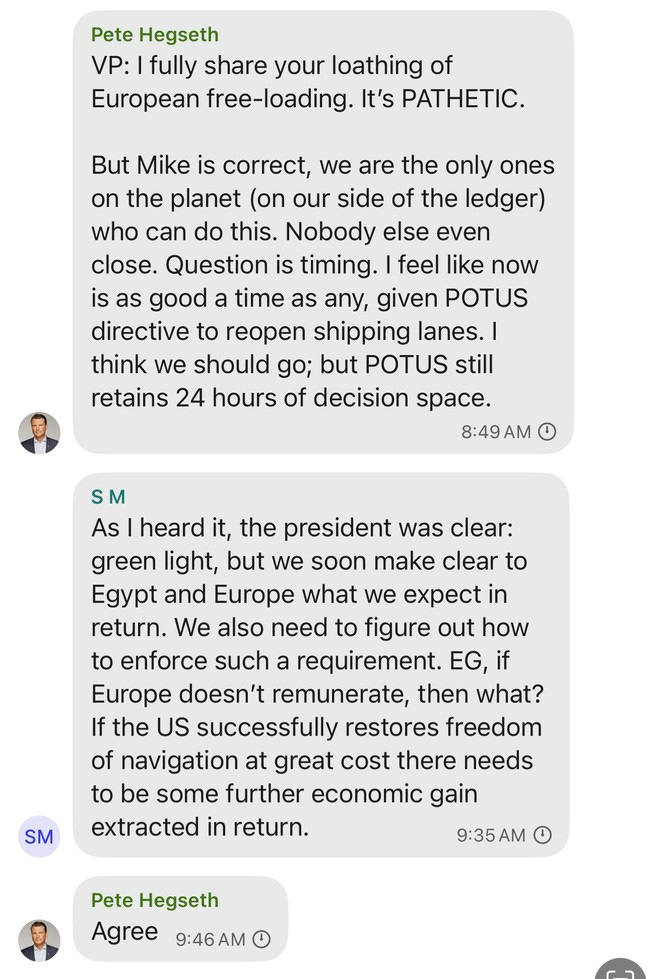Red Sea Blues: Yemen versus the global economy
📡 You know the feeling when you create a WhatsApp group chat and accidently add someone you shouldn’t have ? Well, in a bombshell report today, this is precisely what happened to senior officials in the Trump administration. But this time, the consequences are not just cringe worthy, they’re also a threat to US national security.
Shortly before 2PM Eastern Time on March 15, the world learned the US had launched airstrikes on Houthi targets across Yemen. But remarkably, Jeffrey Goldberg, editor-in-chief of The Atlantic, knew it was coming two hours earlier as someone in the Trump administration had apparantly accidentally (and unknowingly) added him to a Signal group chat where senior officials were discussing war plans in real time.
Yes, seriously…
🔓 The encrypted group thread included:
the Secretary of Defense,
the Secretary of State,
the Director of National Intelligence,
and even Vice President J.D. Vance.
They debated the timing, economic implications, and political optics of launching strikes on the Houthis. They also casually dropped classified intel, target locations, and weapons packages — all over an app not approved for sensitive information, and in front of a journalist; One that is vehemently opposed to the Trump administration no less!
This moment captures everything you need to know about how Washington is operating in 2025: casual, chaotic, and deeply insecure. It also provides an unintentionally candid look at the political thinking behind the escalation in Yemen—not just about Houthis and Iran, but about oil prices, Saudi facilities, European freeloading, and, of course, blaming Biden.
I’m not going to dive in this story more than I should. I’m sure political pundits will be all over it in the coming few days, but if you want to read the full story, click here!
So with that surreal curtain-raiser, let’s rewind, zoom out, and look at how the US, the Houthis, and global trade all collided in the Red Sea — and what it tells us about geopolitics in the Trump 2.0 era.
🇺🇸 It’s not every day you see a US President who once railed against “endless wars” eagerly launching airstrikes in Yemen. Yet here we are in March 2025: President Donald Trump ordered a barrage of attacks on Houthi rebel targets, ostensibly to keep the Red Sea open for business.
In true modern fashion, he even announced it in all-caps on social media, threatening ‘HELL WILL RAIN DOWN’ on Yemen’s Iran-aligned Houthis if they don’t cease their mischief. All this playing out where the Bab el-Mandeb Strait meets the 21st-century global economy.
⚔️ Red Sea Showdown: Houthis vs. Global Commerce
🇾🇪 The trouble traces back to late 2023, when Yemen’s Houthi rebels seized a cargo ship named Galaxy Leader, claiming it was Israeli-owned. It turned out to be Japanese-operated—in regional conflicts, perception is reality.
The ship’s crew were treated ‘according to Islamic principles’ the Houthis insisted, which was cold comfort to shipping insurers everywhere. This was the opening salvo in what would become a campaign of Red Sea harassment:
Missiles and Drones: The Houthis launched long-range missiles and kamikaze drones at ships and even as far as Israel, citing solidarity with Gaza. Their use of increasingly sophisticated drones has put pressure on US naval defenses and raised questions about how a relatively low-budget militia could access such technology.
By the Numbers: Since late 2023, Houthis have attacked U.S. warships 174 times and commercial vessels 145 times. Those numbers are staggering and demonstrate a level of sustained conflict that rivals some conventional war zones.
Hijackings and Threats: The Houthis declared any vessel linked to Israel fair game.
This pirate-esque strategy forced shipping companies to rethink routes and pay a premium for security (or a really good piracy insurance package). This created a sense of unpredictability in global shipping markets. Many shipping companies opted to take the longer route around the Cape of Good Hope, a journey that adds both cost and time.
🎯 All of this chaos had a clear strategic aim for the Houthis (and, by extension, their patrons in Tehran): pressure and visibility. By choking a vital trade artery, the Houthis grabbed international attention and positioned themselves as defenders of the Palestinian cause beyond Yemen’s borders.
It was asymmetric warfare 101 – they couldn’t hit the US or Israel directly on land, so they hit them (and everyone else) at sea. But in March 2025, Trump escalated dramatically, launching the largest US operation in the Middle East since taking office. Jets screamed from carriers, missiles hit targets in Sanaa and Saada, and civilian casualties mounted: at least 31 killed and over 100 wounded, according to Houthi reports.
That’s not exactly the precision outcome the U.S. would want. The Houthis, unsurprisingly, blasted the U.S. for “war crimes” and vowed that their “armed forces are fully prepared to respond to escalation with escalation” In other words: Game on.
Tehran was quick to condemn the strikes, with Iran’s Revolutionary Guard warning of ‘decisive retaliation’ if provoked further. While claiming the Houthis act independently, Iran’s denials ring hollow when UN and US officials have repeatedly intercepted Iranian-made weaponry headed for Yemen.
📊 Red Sea Trade by the Numbers
⛴ Why does this matter? Because this is about more than Yemen. For millennia, the Red Sea has been a prized gateway – from ancient spice caravans to today’s oil tankers and mega container ships. Now it’s making headlines as the Houthis’ target zone. How important is this corridor, exactly? In short: very. Some key stats and facts on the Red Sea and its chokepoint, the Bab el-Mandeb Strait:
12–15% of global trade passes through this route
30% of global container traffic uses the Suez-Red Sea corridor.
9% of global oil, or 9.2 million barrels a day, sails through the Bab el-Mandeb.
50% drop in Suez Canal traffic in early 2024 due to attacks.
The Bab el-Mandeb and Suez Canal are a one-two punch; if either is disrupted, ships must detour all the way around Africa’s Cape of Good Hope. And lo and behold, rerouting traffic around Africa surged 100%, adding weeks and extra costs.
Think about that next time you order something on Amazon that’s shipped from Asia to Europe via the Middle East! More than $1 trillion in goods transit the Suez-Red Sea corridor each year
📉 The economic ripple? Higher fuel costs, longer supply chains, inflation spikes, and spooked insurers. Egypt’s Suez toll revenue has plummeted, while consumer prices everywhere feel the pinch. According to maritime data, shipping costs between Asia and Europe increased by as much as 400% at the height of the Red Sea disruption. Insurance premiums alone jumped more than tenfold for some commercial carriers.
Commercial lingo aside, this isn’t just a maritime issue; it’s a global economic fault line. Food prices in Europe have seen a secondary spike due to delays in agricultural imports. Manufacturing hubs in Asia have had to revise production timelines.
🌎 In short, the stakes are global. A local Yemeni insurgency has managed to rattle one of the world’s busiest trade arteries. This context explains why the US (and other powers) view Houthi attacks on Red Sea shipping as more than just a sideshow to the Yemen war; it’s a direct threat to the global economy’s circulatory system.
Of course, the Houthis know this – that’s the point. By threatening international shipping, they gain leverage and spotlight that far exceeds their local strength. It’s a classic case of a “weak” actor exploiting a strong actor’s vulnerabilities.
But when a ragtag group in northern Yemen can derail global supply chain, it says more about the vulnerability of the system than about the strength of said group.
🤔 Who Are the Houthis?
🥷 The Houthi movement – formally Ansar Allah (“Supporters of God”) – began in Yemen’s northern highlands, but today they’re on the global stage (for all the wrong reasons). Think of the Houthis as a cocktail of religious revivalism, local grievance, and geopolitical proxy all rolled into one, with a catchy (if disturbing) slogan to boot: “God is the Greatest, Death to America, Death to Israel, Curse be upon the Jews, Victory to Islam”
A little ideological and historical background: The Houthis hail from Yemen’s Zaydi Shiite community, a branch of Islam that ruled North Yemen for 1,000 years until 1962. Zaydis are often called “Fivers” (in contrast to Iran’s “Twelver” Shiism).
In a nutshell, they emerged in the 1990s as a reaction to growing Saudi-funded Wahhabi influence in northern Yemen. Since 2015, the Saudis (and UAE) have tried to bomb them into submission, to no avail. Iran stepped in with weapons, training, and strategic advice. Today, the Houthis boast a stockpile of drones and missiles—many based on Iranian designs—and increasingly behave like a regional militia with long-range capabilities.
🇮🇷 So are the Houthis Iran’s puppets? Yes and no. They’re not a creation of Iran—they emerged from Yemeni dynamics—but Iran’s patronage supercharged them. Iran’s involvement is real – they’ve provided arms, training (likely via Hezbollah proxies and IRGC advisers), and political backing. The Houthis have in turn made themselves a thorn in the side of Iran’s enemies (Saudi, the US, and now even Israel).
Crucially, the Houthis have shown they’ll act in line with Iranian interests (e.g., attacking shipping when it pressures the US and Saudi), but they also guard their independence
🇾🇪 Yemen: A Graveyard for Foreign Ambitions
🪦 Yemen has earned a reputation as a graveyard of foreign ambitions – a place where outside powers often get stuck in the sand and come to regret it—Afghanistan tends to get all the quagmire metaphors, but Yemen is right up there:
Egypt (1960s): Nasser’s ‘Vietnam’ 70,000 troops sent, 10,000 lost.
Britain (1967): Forced to abandon Aden after a costly insurgency.
Saudi Arabia (2015-present): Entered expecting a swift win. It’s 2025, and they’re still stuck.
More than a dozen foreign interventions have failed to subdue the country across centuries. Ottoman forces called Yemen ‘the land where armies go to die’.
Even recent U.S. administrations have acknowledged this risk. Classified Pentagon assessments dating back to 2017 warned that no military strategy in Yemen would be successful without a viable political resolution. Trump’s campaign of strikes may hit targets, but whether it changes realities on the ground is an open question.
So, when the U.S. now ramps up its direct military role against the Houthis, it’s stepping onto a well-trodden minefield of history. Trump’s strikes may be limited to air and naval actions (no US ground invasion is on the table, thankfully), but even so, the risk of mission creep or unintended consequences is real.
💥 The Houthis have shown they can retaliate in creative ways – perhaps by targeting US partners’ interests (e.g. launching a missile at a Saudi oil tanker, or striking a US military base in the region with a drone). They might try to make the Red Sea uninsurable for shippers, calculating that global pressure will then rain down on Trump to stop the campaign.
In asymmetric conflicts, the side that doesn’t have to win outright—only avoid losing —often has the edge. And here’s where the irony gets rich: The Trump administration finds itself in a mini-war in Yemen largely to secure global trade, a far cry from the America First, anti-globalization, ‘why are we policing the world’s sea lanes rhetoric that Trump sometimes deployed. Which brings us to the awkward matter of US policy inconsistencies.
The lesson from all the above: intervening in Yemen tends to be like wrestling a cactus – you end up bleeding, not the cactus.
📂 Trump, Tulsi and Flip-Flop Policies
🔎 Remember when Trump denounced endless wars? In 2019, he vetoed a resolution to stop US support for Saudi Arabia’s Yemen campaign. Now he’s back with airstrikes on Yemen, that even Congress didn’t explicitly sign off on.
Even more ironic: Tulsi Gabbard, now Trump’s Director of National Intelligence, once decried Yemen intervention as illegal and genocidal. Now she’s calling on allies to join the bombing campaign.
Washington has a way of doing that to people. In Tulsi Gabbard's case, her justification hinges on ‘protecting global commerce’, but the reversal still raises eyebrows.
💬 It also signals a broader trend: foreign policy decisions increasingly driven by economic security rather than ideological or humanitarian principles. It's not about spreading democracy; it's about keeping the sea lanes open and prices stable.
Yet the optics of American warplanes bombing yet another Middle Eastern country (arguably the poorest one) are… complicated. It gives fodder to both Trump’s critics and some of his far-right supporters who actually agreed with his old anti-war stance.
There is a domestic political calculus here too: looking tough on Iran and terrorism might score points, but getting entangled could backfire if things go south. It’s a thin line to walk, especially with a skeptical public.
So we have a bit of a policy paradox: Trump’s Washington is effectively continuing what Biden quietly started—using force to protect the Red Sea—even though both administrations had tried to avoid deeper Yemen involvement earlier.
📌 So…What’s Next?
Escalation and Tit-for-Tat: Houthis could aim for high-profile targets — oil terminals, U.S. bases, or Israeli-linked ships. They’ve already launched long-range missiles at Tel Aviv and threatened retaliation against any state that cooperates with the US
Diplomacy: Oman may mediate. Iran might use the moment to bargain for nuclear or sanctions relief. Saudi Arabia may re-enter talks with the Houthis if the pressure gets too high.
Ceasefire Leverage: If Netanyahu halts Gaza operations, the Houthis could stand down. The two fronts are increasingly intertwined.
Domestically, Trump will tout any success – if US strikes significantly diminish Houthi capabilities, he’ll claim victory for protecting commerce. If the Houthis pause or stop attacks, expect a victory lap.
Conversely, if a US ship takes a hit or casualties mount, the administration could face political blowback. The balancing act will be how long to keep up the campaign. US officials hinted the strikes might continue for weeks until the Houthi threat is ‘degraded’.
⏳ But the thing about asymmetric threats is that you can degrade them to a point – not eliminate them without either a political deal (something the US doesn’t know how to do anymore) or a massive ground effort (something the US doesn’t want to do). Trump will want to avoid the quagmire scenario (he’s keenly aware of that risk). So possibly, the US will strike hard for a short period, then declare ‘mission accomplished’ once the immediate threat subsides, pivoting to diplomatic efforts. Essentially a show of force followed by a hope that deterrence sticks.
For my handful of subscribers (and even less still who made it this far!) The takeaway is this: globalization’s circulatory system—those sea lanes and trade routes—often runs through unstable neighborhoods. Protecting them can lead to messy entanglements, and the line between naval policing and war can get blurry. Companies and governments alike now have to factor in Houthi rebels (of all people) when calculating shipping logistics and insurance.
It’s a reminder that political risk doesn’t stop at the shoreline. In the meantime, perhaps one of the solution to all this mess, is actually forcing Benjamin Netanyahu’s hand in negotiating /respecting a ceasefire in Gaza that will make the Houthis stand down.










